EASY CHERRIES
Sweet, Juicy, & Tolerant
Nanking cherries (Prunus tomentosa) are now at their peak of perfection, sweet and sprightly flavored, brilliant red in color, still firm, and, as usual, abundant. Nanking cherries are very juicy and not stingy to release the juice. Straight up, it’s the most refreshing juice imaginable.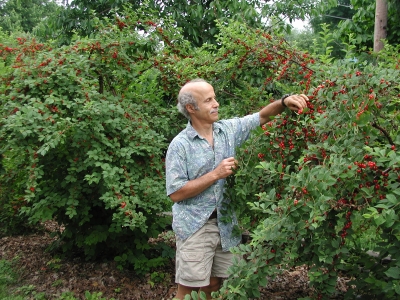
You’ve never heard of Nanking cherries? Understandable since they are an uncommon fruit. (And warranted a whole chapter in my book Uncommon Fruits for Every Garden, now out of print but in the works for updating and expanding.) As the name tells you, they are native to China, more generally to the cold, semi-arid regions of Asia. This provenance tells you something about the toughness of the plant, where it weathers winter temperatures below minus 20 degrees F. and summer temperatures as high as 110 degrees F.
Quite a Looker Also
Nanking cherries warrant planting for more than just their fruits. They’re among my top recommendations for “edible landscaping.” The bare stems of the row of a dozen of these bushes along my driveway burst into pink-tinged, white blossoms every year in mid April, blossoms so dense that they pretty much hide the stems. (Nanking cherries do appear in my book Landscaping with Fruit, which is in print and available now.)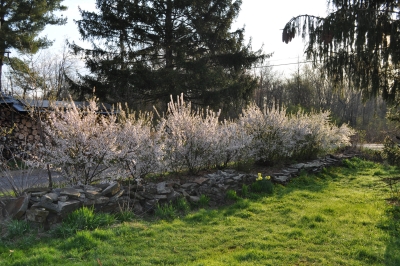
The plant was first introduced into this country in 1882, and the horticultural world was enthusiastic about it but couldn’t decide whether promotion should be for its beauty or its fruit. Back then, you had to choose; nowadays Nanking cherries fit neatly into the category of edible landscape plants.
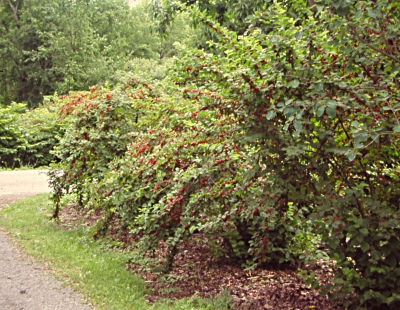
Ornamental flowers followed by pretty and tasty fruits
Early on, plant breeders started working for improvement not only within the species but also by hybridization with such related species as beach plums and sand cherries. Some varieties were selected and named, none of which are, as far as I can tell, available anywhere these days.
No matter. I grow all the Nanking cherry plants I want by merely planting seeds. Blossoms and fruits conveniently follow within two or three years. While flavor and ripening season vary slightly, I’ve never tasted a Nanking cherry that wasn’t topnotch.
If I was to become a plant breeder, which is not my plan, this is the fruit I’d work on. Even run-of-the-mill seedlings taste good. The fruit is admittedly small, 3/8 to 1/2 inch across; I’d breed for increased size. Still, they’re a perfect fruit for ambulant consumption and especially for children, who are in no rush to fill a container. A friend whose son is not a fan of fruits stated that they are much better than grocery store cherries. And much more reliable.
My first introduction was to Nanking cherries as an ornamental. When I was in graduate school in Madison, Wisconsin, I’d ride my bike to campus past a golf course bordered on the street side by a sheared, tall hedge that presented a vertical wall of cherries on which to feast. These shrubs that can grow as large as eight to ten feet tall and wide. The only care my driveway plants get is whatever it takes to keep plants from growing that large.
No Work
Nanking cherries couldn’t be easier to grow. Just give them full sun and reasonable soil. After writing “full sun,” I just remembered a shrub I often biked pass that grew for years in full shade. No fruit though. Besides shade, the reason for lack of fruit was because a mate was needed. Cross pollination is needed in order to set fruit: two or more plants equal two or more plants bearing fruit.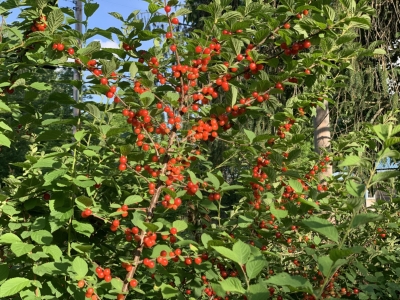
I set my first Nanking cherries in the ground (in Delaware) over 40 years ago, and only two seasons have they failed me. One of those seasons (here in New York) temperatures in early May plummeted to 14 degrees F. The frozen blossoms and fruitlets were understandable.
The other fruitless season was the year or two following that freeze. Nanking cherries are resistant to just about all insect and disease problems, except one that causes occasional wilting and dieback of some stems. It’s a bacterial streaming disease that lives inside tissue. The situation was getting so bad here, probably due to a weakening effect that freak heavy freeze, that I decided to lop all the stems to ground level, and cart them off site, to drastically reduce inoculum. Since then, and it’s been a number of years, plants are doing fine.
Free for All
When waxing enthusiastically about Nanking cherries, I’m always asked, “What about birds?” Most cherries are difficult enough to grow and if they do bear and insects and diseases have been fended off, birds become the problem. Nanking cherries bear so heavily, sometimes to the extent that fruits hide the branches, that birds can eat all they want as can squirrels, chipmunks, me, and other humans. Still, if you take a look at the bushes, it looks like harvest has not yet begun.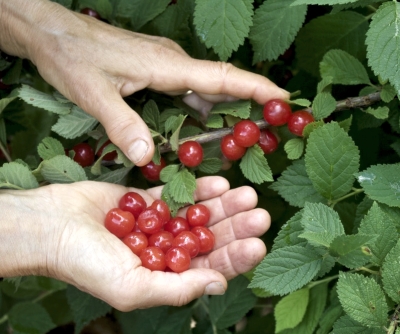
Nanking cherries would make superb cherry pie if the fruits were not so small as to make pitting tedious. At least you don’t have to pull off the stems, which remain attached to the bush at harvest. And the pits are small.
As I wrote, though, I consider that the best way to enjoy Nanking cherry fruits is to walk up to a plant and strip the ripe fruits off into your mouth right then and there.


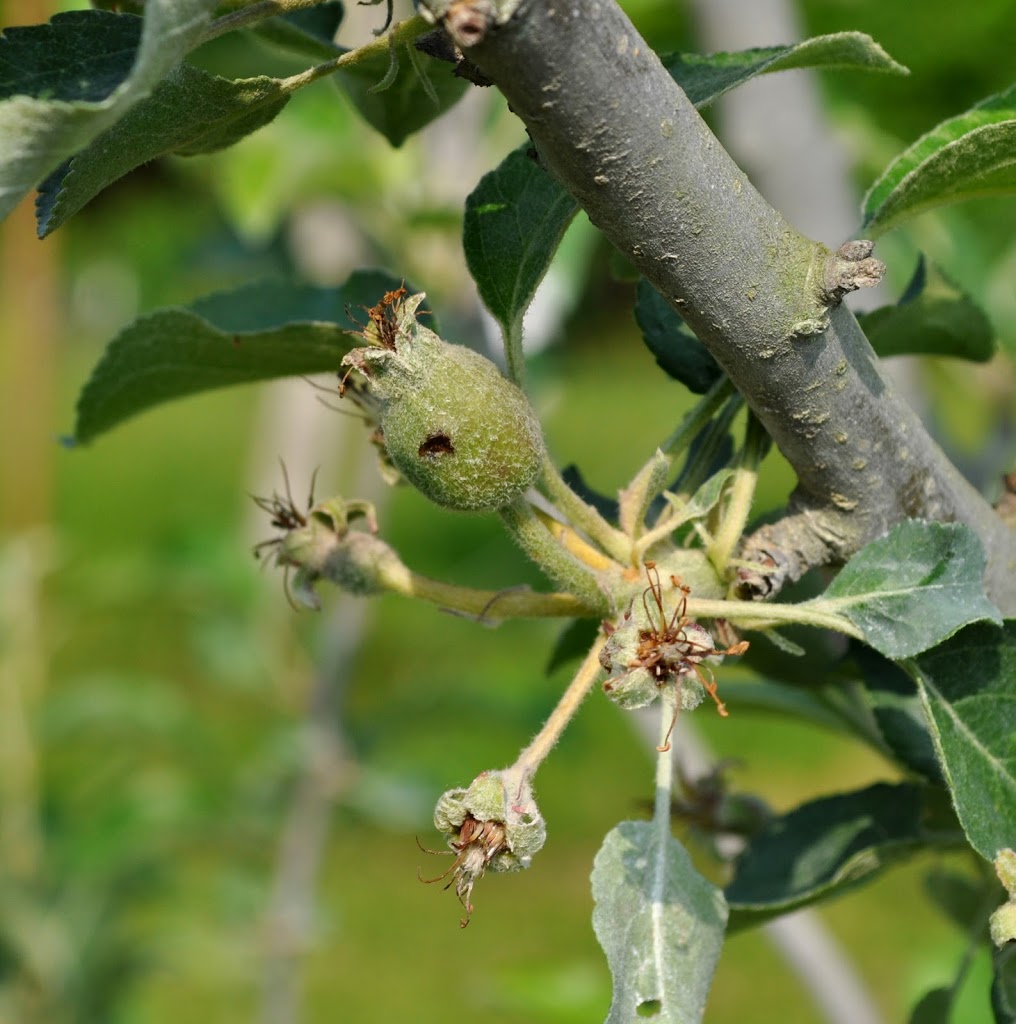
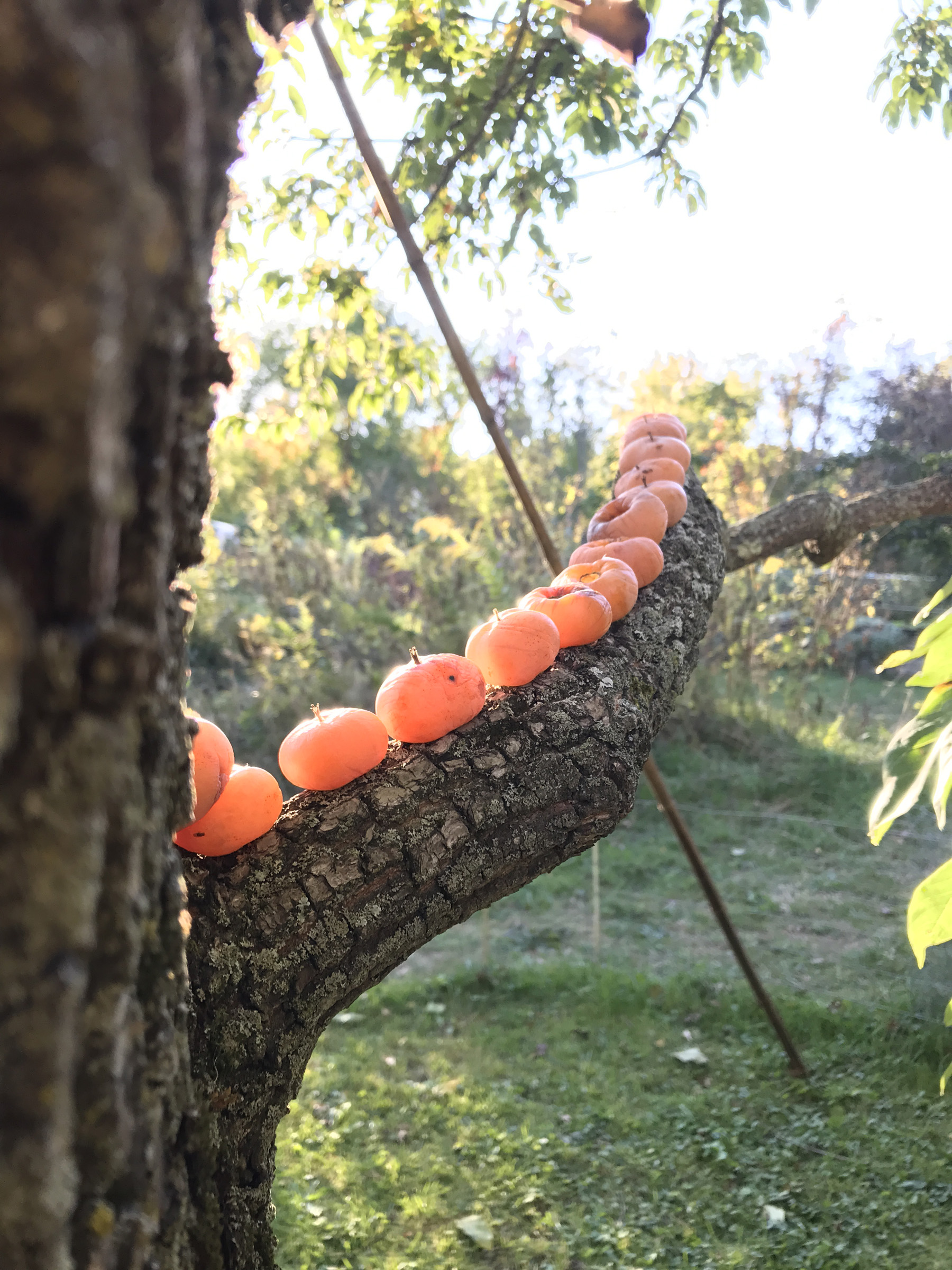

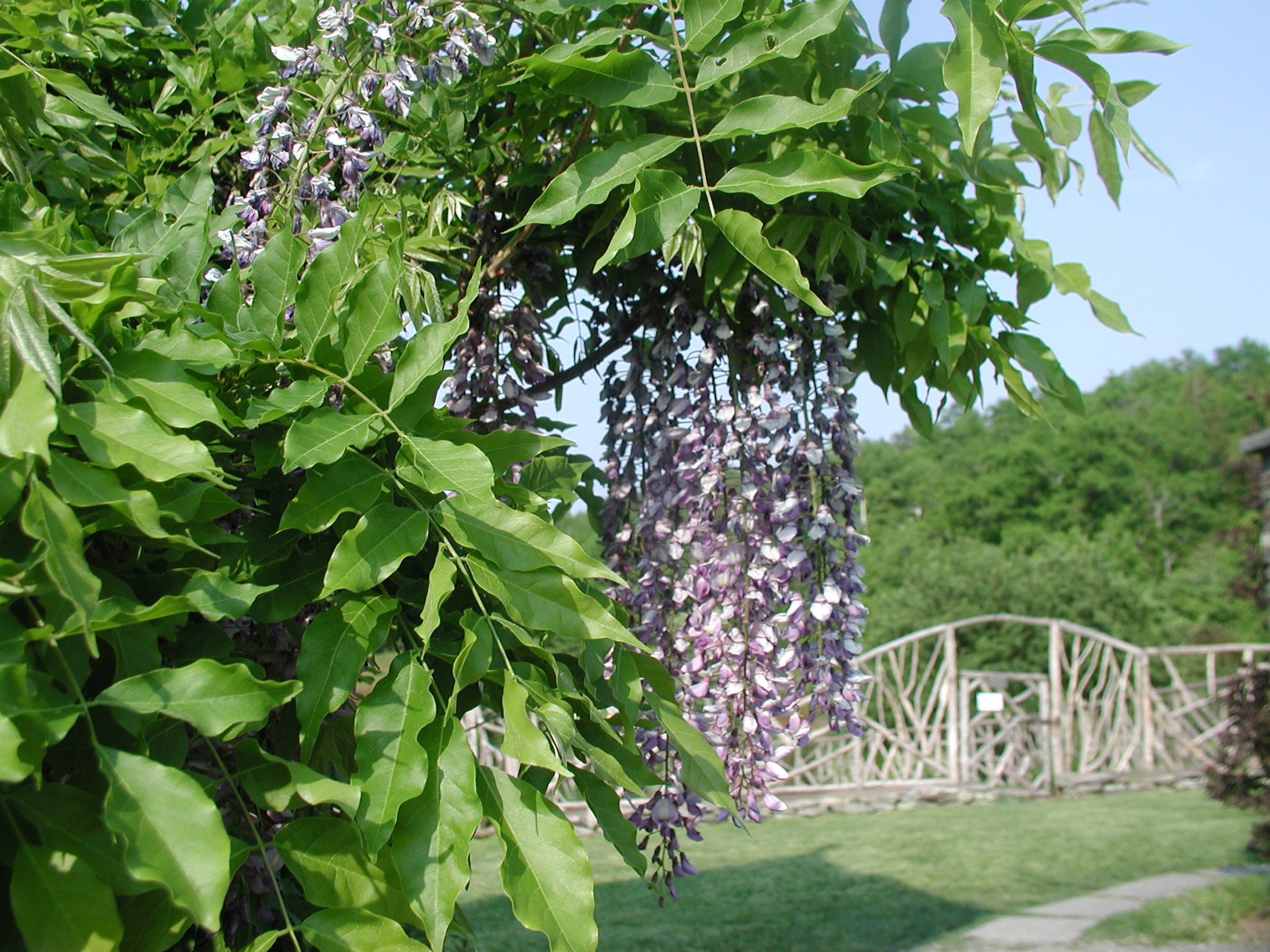
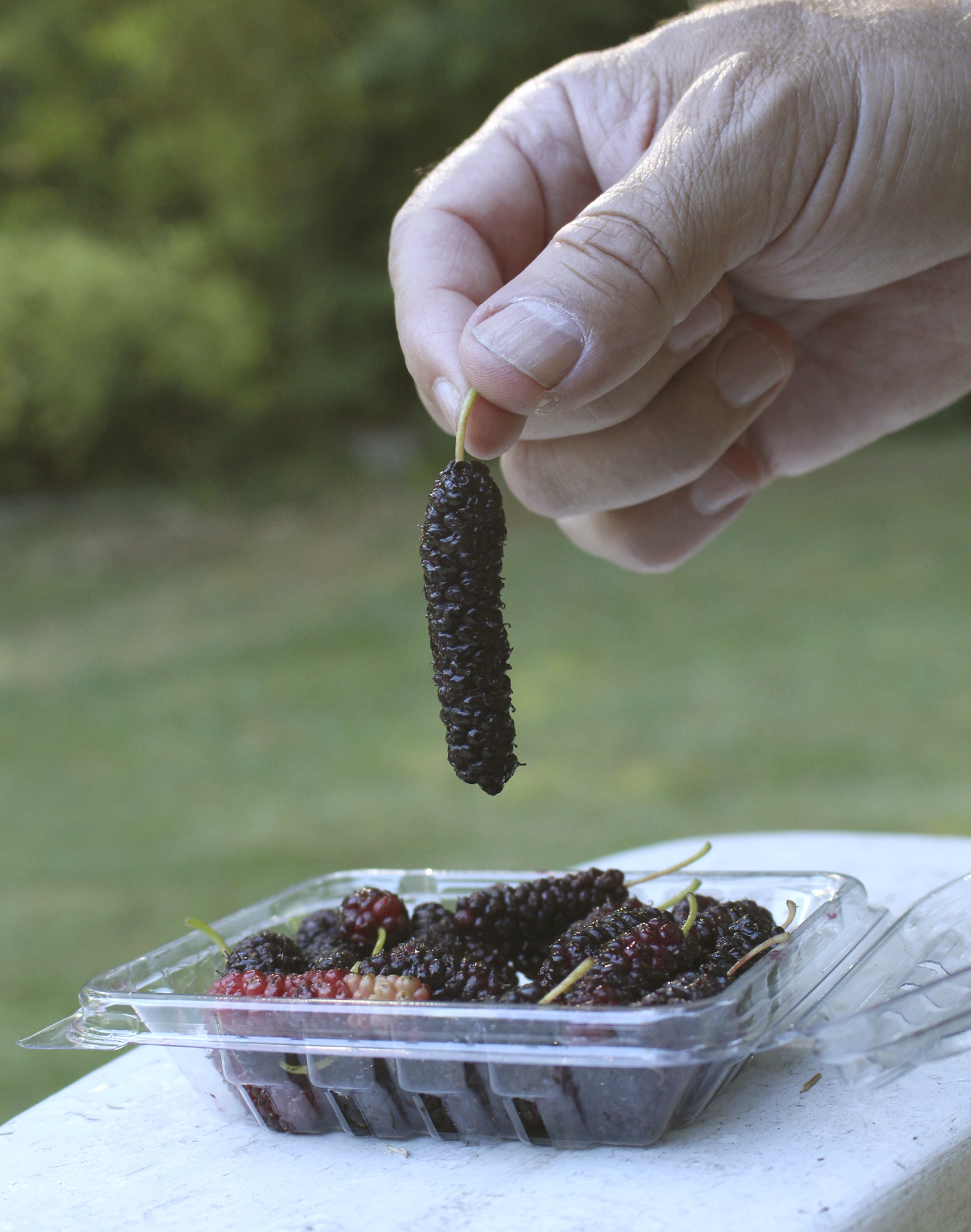
Hi Lee. Nanking cherry sounds fabulous! I’m in zone 5b in coastal Maine. This shrub sounds like it might work here. Can u provide any growers for purchasing? Thx
I suggest a web search for Prunus tomentosa.
Very interesting Lee I’m going to order some. Our regular cherry has just produced only it’s second crop ever. For the first time in fourteen years three apricots were covered in blossom in early April which coincided with three unusual eighty five degree days here in Iowa. The trees were black with pollinators. Most interesting were huge swarms of moths feeding at dusk, which I’d never seen before. Now preparing for bushels of apricots.
Good luck.
I have had three Nanking Cherry bushes for about twenty years. The chipmuNks adore them and will strip the bushes clean. I tied row cover over each entire bush and tied it on the bottom so the chipmunks couldn’t get in. Then…cherries galore.
Fedco in Maine sells them under the category “small trees and shrubs”.
The blooms are early, but this year very few due to February arctic blast. Only the branches under snow bloomed.
Also, mice ate the bark all around one trunk one winter, but since it is a bush, it “bushed” right out again, despite losing its main trunk or branch.
Lovely shrub!!! And delicious fruit. I am growing it on the mountainside near Middlebury, Vermont.
It’s a tough plant that’s easy to grow and yield delicious fruit. Chipmunks live in the stone wall right next to the plants but don’t make a dent in production.
Did you find a good trunk guard to protect from rodents nibbling?
I use either half-inch “hardware” clothe (it’s metal) or the plastic spirals sold for the purpose. I remove the spirals in spring, store them, and then re-use them the following fall.
Hi Lee, I don’t recall if what I planted 10 years ago was Nanking: I believe the variety was Carmine jewel or Crimson Jewel? They are growing too big, the cherries are slim to none. They also get a sticky substance on the stems and some tiny tiny worms early on. Not happy!! Can I cut them back hard and will they regrow? They are in full sun, 5 of them, about 8 feet apart.
They will regrow but will take a couple of years or more to potentially fruit. I’ve grown those varieties. They are quite different from Nanking, and much harder to get to fruit. Lots of pests.
How do you pit these tiny cherries?
I don’t. I spit them out as I eat them right from the plants. I have heard of people pitting them, though. But I didn’t investigate further because however they did it would be too tedious for me.
My family uses a steamer to juice them.
Are they deer food?
Yes, probably, but they eventually grow too dense and fast for deer to make a significant dent. (I also have lots of bushes.)
A large paperclip works great for pitting Nanking cherries as the cherries are big enough to get trapped between the large outer loop and the smaller inner one.
Correction: The pit gets trapped between the loops of the paperclip. Insert the paperclip where the cherry connected to the stem.
Thank you for this! I just bought a Nanking Cherry bush and was wondering how I would ever pit the cherries. Excited!
We’ve been growing these beautiful cherries for a few years now. Sadly we lost one due to the spungy moth caterpillar and heavy frosts, but our other two have survived. The fruit is ready (June 27) and we will pick them very soon. I love these cherries, they are different and so delicious, I highly recommend them!
Interesting. They didn’t touch mine. But the moth outbreaks do seem to be random.
We planted our Nanking cherries about 4 years ago, here in Colorado, south of Denver. This year we had blooms galore, early pollen for the bees and a bumper crop of fruit around June 25. The grandkids loved picking the lower branches clean. I used a masher to separate pits from flesh, made some delicious cherry jelly. The robins and chickadees ate to their hearts content too. Looking to add more bushes next year. Thanks for all your tips.
My pleasure.
Hello Lee,
I’ve been growing some nankings since I saw you on GGW, year three. Do you know them to be susceptible to bacterial cankers? I have had a problem with it on the property and have gotten rid of all infected trees. They look pretty good now but was curious if you have heard of that on them specifically.
Thanks! I love your work and your farmden.
Cheers!
-Parker
I don’t know about canker but they do get a bacterial streaming disease. I’ve kept it under control with pruning — dramatic pruning if the infection becomes widespread. I wrote about it in https://leereich.com/2023/06/easy-cherries.html
I have two bushes and get lots of cherries. What is your process for planting the seeds? I tried germinating some last year, but had zero success. I left them in a plastic container in my unheated shed over winter and planted them in the spring, but nothing.
Nanking cherry seeds, like those of many other woody plants, need stratification before they will germinate. Stratification in cool (32-45°F), moist conditions for a couple of months or more. I put my sees into into the refrigerator in a plastic bag in along with moist potting soil. If the seeds are all dried out, I soak them for 8 hours first.
Hi Lee,
I heard you on the Joe Gardener Show Podcast and am hopeful to expand my fruit collection. Do you think Nanking Cherry can withstand 120 degrees in the summer desert (Las Vegas and Phoenix)? And would it be doable in a 15-gallon pot?
Thank you for your help and insight.
Yes, to both questions. Probably. Make sure the outside of the pot is a bright color to reflect the sunlight. Roots might not be as tolerable to heat as the stems.